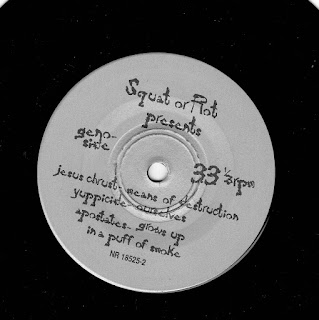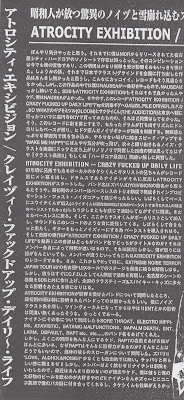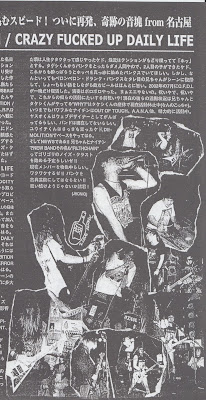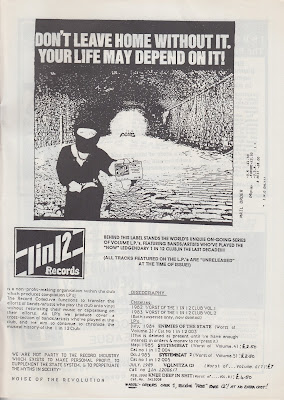Fuck me, it has been a while. Just sitting on my arse thinking about Terminal Sound Nuisance right now makes me feel like I have just come back from long holidays and I have to go back to work, except work in this case is actually pleasant and something I like to think I am pretty decent at. I know I have been threatening to be more concise in the past without ever actually shutting up but things have changed. Just to be serious for a second, I have a new job (gasp) that I have to adjust to - and not just by groveling with servility whenever I meet my boss - so that a lack of time is not completely unimaginable. Ideally, I should try to be more straight-forward or, as my mum used to tell me when I was a teenager, just cut the crap. Either this or I won't do the blog as often as I used to which sounds just sad. Tough shit. Does it mean that I am not looking for anything serious right now? Does it fuck. If anything, writing shorter writeups - or "grandiose articles" as my numerous fans like to call them - means that they will be packed with action and almost devoid of transitions with little to no time to reflect on anything, not unlike a Marvel movie with Deviated Instinct replacing Captain America and shoegaze replacing whoever the new vilain is.
So... Still believing in ANOK is a series that I have designed, with my proverbial craft, to take a breather from the endless crust series I previously embarked upon. Don't get me wrong, I love crust to death but right now I'd rather run away to Colorado to become a Tantric nail artist or open a vape shop in Slough than write about how great Nightfeeder (and they are great indeed). So I'm definitely pulling a sickie on crust music for a couple of months. What will Still believing in ANOK be about beside sounding like a poor attempt at reconciling The Exploited and Crass in one unspectacular pun? Well, I picked about a dozen works recorded and/or released between 1987 and 2001 - a period that could be broadly described as "pre-internet" because the digital revolution was yet to come and had not yet had the formidable impact it would soon have on punk as a whole. And the recordings I chose all built on the so-called traditional anarcho sound of the original wave. Of course, the 90's were replete with politically-motivated anarchopunk bands all around the world, but in this series I will be focusing on the bands that did not go full on hardcore or crust or thrashcore or whatevercore but kept that distinctive old-school edge and flew with it. Basically, form (genre in this case) will prevail over content and concept (the politics and the DIY spirit). So yeah, expect a lot of Conflict worship.
Exhaustivity, like perfect shaped abs, is a chimera. Still, the focus will be international and, as much as possible, the bands tackled will aptly and meaningfully reflect the whole range of the foundational anarcho sound, or rather sounds indeed as there was a lot of variety originally. Even though we have come to identify a specific, if rather wide-spread at the time, take (let's say Flux meets The System and The Mob for example) as "the classic anarchopunk sound" and even though there was such a thing as generic, average anarchopunk bands in 1983, there was still variety enough, from Poison Girls to Antisect, Zounds to Stalag 17. One of my goals will be to highlight that this variety in speed, songwriting, influences, tones and so on did survive, even though, of course, there was such a thing as "the classic 90's anarcho sound" that was different and very common and epitomised by bands like Aus-Rotten for example. Bloody cycles. There will be some obvious choices and hopefully some bands you will have never heard of. There will be tunes, there will be anger, there will be passion, there will be some inept pieces of songwriting, strange solos, anarchoer-than-thou lyrics, Crasser-than-thou artwork and fake English accents.
Let's start with a band from Germany. We don't often do classic punk from Germany on Terminal Sound Nuisance, not just because the country perversely birthed the notion that it is fine to have a mullet, a mustache and listen to heavy metal, but because I have never been a massive fan of deutschpunk. Yes Chaos Z, Vorkriegsphase or L'Attentat were great but I was always under the impression that 80's German punk-rock sounded a bit distasteful, not as much as French punk-rock - few countries can boast bands as embarrassing as ours - but still not generating enough enthusiasm. A bit like second-hand sweatpants. Just not that exciting. Enola Gay were clearly not your typical 1-2-1-2 drunken mowing that young punks like to pogo to. Information about Enola Gay are scarce to say the least. In fact, amazingly, only three songs of their 1986 Lp White Control Means Bloody Murder are on youtube, a failing that is the modern equivalent of barely getting a fiver after busking on a rainy wednesday afternoon.
The band was from Hannover and openly borrowed from the anarchopunk and peacepunk aesthetics, the Lp focusing a lot on the anti-Apartheid struggle, but google is unusually quiet about this lot. Sonically, although it would not be entirely true to qualify the album as a typical anarcho recording - there are hints of European hardcore punk - the spoken words, some of the moodier bits and songs are certainly reminiscent of Anti-System, Civilised Society or Conflict. This heavily UK-oriented sound could also be found in another 80's German band called Anti Heroes from Oberhausen (they were more of a mid-paced affair though) who had a song on a compilation called The ALF is watching and there's no place to hide... where you could also find Naturecore, Oi Polloi or Chumba. But, where Anti Heroes were just enjoyable, Enola Gay were arguably a very good band, a great one even when you consider their Ep Censored Bodies - Human Fission.
Recorded in 1987 only one year after the release of the album, but released in 1990 when Enola Gay were no more, the Ep would totally fit in the "classic records that no one knows" category, which I'm aware is something of an oxymoron since a record becomes a classic through the acclaim of a significant portion, and not just three nerds who are still constantly connected to soulseek in 2023. Maybe the band shot itself in the foot by taking a name that I suppose would have already been taken by the Danish Enola Gay, a band that is undeniably much better-known now than their German counterparts, although it is difficult to assess their popularity "back in the days" outside of Denmark. Our Enola Gay did appear on a tape released as early as 1984 that included live recordings of bands that played the Ajz venue in Bielefeld (you also have established bands like Neurotic Arseholes, Upright Citizens and even Wretched) so timing may not have been of the essence. There have been quite a few Enola Gays afterwards too so that homonymy may also have impaired the band's status, even more so with France's best 90's crust band having the same name. As a result, these German peace punks have remained a footnote, a cruel fate when one considers that many would be into their sound.
In any case, you can thank me whole-heartedly because if you are a fan of 80's anarchopunk then Hannover's Enola Gay are for you. With such a piece of knowledge, I guarantee you will be able to quizz and surpass rivals in order to ascertain your total domination over the local punk scene. Sure, the band was a little late to the 80's anarcho party but close your eyes, play the record, listen to the songwriting, the lyrics and you will have the impression, no the absolute certainty, that you have just unearthed an unreleased Mortarhate record from 1985. On this recording session, Enola Gay also have a female singer thus further reinforcing that classic UK anarcho touch. The first number, a feminist song, is reminiscent of The Sears and Civilised Society? while the next songs lovingly point in the direction of early Anti-System and Conflict for the first one and Icons of Filth and, well, Conflict again for the second (unsurprisingly the infamous Londoners were a major influence at the time). The last one, my favourite, is a deliciously fast and anthemic punk number with dual vocals not unlike Iconoclast and Potential Threat covering Toxic Waste's songs. Energetic punk at its very best. If this had been released in 1984 on Spiderleg or Mortarhate, we'd all be wearing Enola Gay shirts today, and by "all" I mean the same three nerds that are constantly connected on soulseek.
I am absolutely clueless about what the members became afterwards and to be honest, I don't really remember how I initially came across Enola Gay (through a blog I assume but I have not been able to track it). Censore Bodies - Human Fission was released on Enola Records (the band's own entity) and Double A Records (a label that was also responsible for Stengte Dorer, Sons of Sadism or the Attack is Now Suicide Lp). This Ep does not go for obscene prices on discogs so if you bump into it, you know what to do.






































































